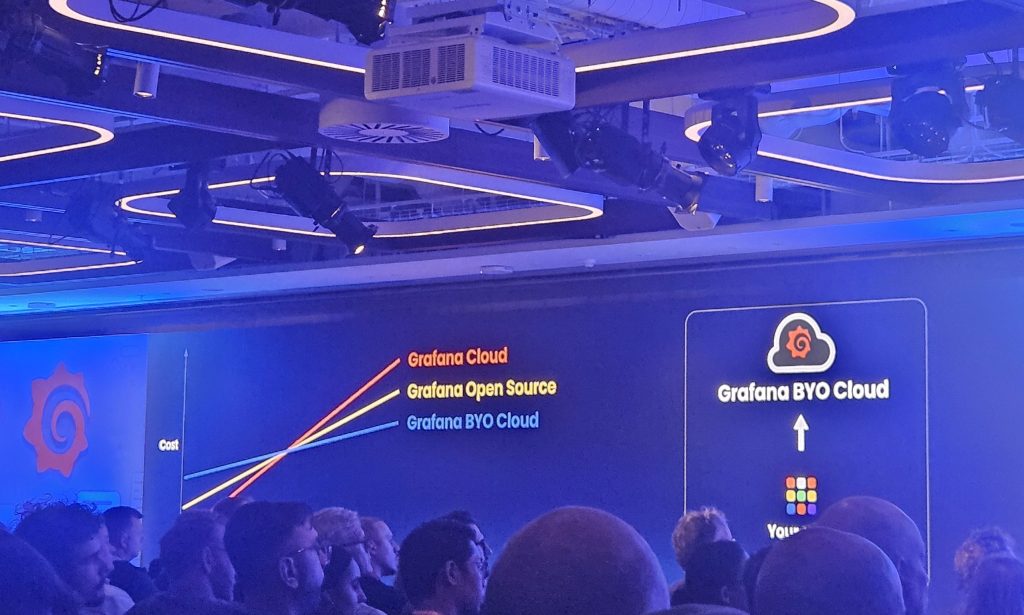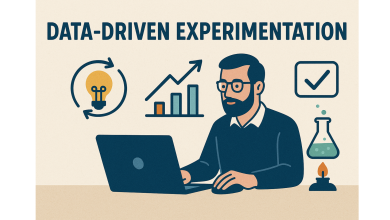
Tired of sassy service providers charging through the roof for complicated and limited data management systems? You’re not the only one.
The golden days of SaaS (Software as a Service) may soon be over, as BYOC (Bring Your Own Cloud) paves a new way for large-scale businesses to see value from their data in the AI era.
In today’s increasingly data-oriented landscape, many large-scale organisations are running into problems such as escalating costs, vendor lock-in, and loss of data sovereignty, when using traditional SaaS packages. For this reason, several SaaS providers are now offering BYOC deployments as a way to retain or attract large-scale customers.
Case Study: BYOC at Grafana Labs
Among the SaaS providers now offering BYOC is Grafana Labs, a leader in observability. At their recent ObservabilityCON 2025 in London, the company announced that their full-stack observability toolkit is now available as a BYOC deployment. Previously, this was only available through their fully managed platform, Grafana Cloud.
To understand the growing appeal of BYOC for both large-scale customers, and SaaS providers, we spoke with Tom Wilkie, CTO at Grafana Labs.
According to Wilkie, while SaaS deployments remain a viable option for small to medium enterprises, the logic of their cost-efficiency starts to break down for larger organisations. This is because of the availability of open source software, which means that when SaaS costs start to skyrocket, customers have the alternative to just go and find some engineers to use open source software on their on-prem data, or do in-house training.
“For large-scale customers, SaaS breaks down because there’s this second option of running open-source. And you do see large customers of Grafana Cloud get to the point where they’re spending so much with us that it becomes more cost-effective for them to go and find a team of people to run our open-source instead. So they could go a find a team of engineers to build the features that they miss from Grafana Cloud on top of our open-source, and run it themselves. And this is actually one of the reasons we do open-source, because it gives our customers optionality, it gives them leverage, it prevents them from getting locked in with us, and it makes us work for their value.”
Theoretically, going open-source and keeping data on-prem also gives customers the benefit of being able to build their own data architecture and design tools best suited to their own specific needs.
However, due to the rapidly evolving state of AI technology, these tools and architectures are becoming more complex, powerful, and therefore expensive to manage. Just to give you an idea, the average annual salary for a software engineer in the US is approximately $80,000, which can hike up to $122,000 for AI specialism, and just over $174,000 for senior engineers.
So this is where BYOC comes in. This allows large-scale organisations to enjoy the benefits of expertly designed data architecture, and AI-driven tool capabilities, but in their own cloud region and at a flat rate that makes it easier for them to predict their outgoing monthly costs.
“BYOC is a method for us to deliver our AI technology to [large-scale] customers, because the AI technology we build is proprietary.”
Additionally, BYOC doesn’t just financially benefit large-scale customers; it also benefits the SaaS provider, especially in situations where the customer would otherwise go open-source.
“BYOC is a win-win option. This is because it’s a non-consumption based, flat rate, and they get to use their cloud commits, but then it’s basically pure margin for us because we’re not paying for the infrastructure costs.”

But economics aren’t the only driver behind Grafana’s decision to offer BYOC. There is also an altruistic aspect to the decision, which traces back to the company’s open-source roots.
“Fundamentally for us, the BYOC topic is wrapped up in the reason we do open-source. It’s wrapped up in the position we hold in the market and in the relationship we have with our customers. You know, we actually want our customers to have a choice.”
Add to this the fact that the SaaS market is crowded and highly competitive. This means that creating the optimal customer experience, by offering adaptable and customisable options such as BYOC, may be a higher priority for SaaS vendors than ever before.
This is going to be especially true for vendors such as Grafana, who are building advanced, AI-driven toolkits, which are mostly designed for bigger and more complex data architectures.
“[This means] some of our customers miss out on the innovation we’re building at Grafana Cloud. For example, the really big ones, who choose to go open-source, they don’t get Adaptive Telemetry, they don’t get our AI assistant. All our solutions, our Knowledge Graph, all this value that we’ve been putting a lot of time and effort into, that we’ve built in our managed solution – they don’t get to have it, and so we wanted to find a different model to traditional SaaS.”
Deploying BYOC as a SaaS Vendor: Know Before You Go
So far in this article, we’ve painted BYOC deployment in a pretty straightforward, convincing light. But is it all really that simple? And if so, why aren’t the majority of SaaS providers offering it?
*While there are currently no definitive statistics on the proportion of SaaS vendors offering BYOC, ChatGPT estimates that a minority but meaningful share (20-40%) of enterprise-oriented SaaS vendors offer BYOC.
The number one reason for this is the problem of integration between different cloud regions. Configuring the data architecture built for one cloud within a new cloud environment not only creates a real headache for software engineers, but it can also reduce the efficacy of the original toolkit.
Additionally, due to the varying restrictions on data-sharing and AI in different regions of the world, it could even cause the vendor to run into legal/compliance issues.
To combat these potential hurdles, Grafana limits its BYOC deployment to customers whose cloud region is architecturally the same as a normal public region.
While this means that they could potentially miss out on a few customers, it takes a huge cognitive load off their engineers, and allows them to configure the architecture in a formulaic way that ensures the functionality of the software capabilities.
“One of the internal pillars of our BYOC strategy is that every BYOC region has to be the same as a normal public region. So our engineers can’t know the difference, and shouldn’t be able to. And this is really about cognitive load, because engineers can’t remember exceptions for 50 different regions, for example.”

Another key consideration is that the tools and services offered in the original managed cloud may not all be suited to BYOC. If this includes a key service within the software’s overall infrastructure and functionality, this could significantly reduce the appeal of the BYOC deployment for customers.
Grafana mitigates this issue via a ‘credit system’. This gives BYOC customers a number of credits that allow them to use the services unavailable through BYOC on the vendor’s public cloud.
“One of the things we include with many of our BYOC customers is a small amount of credits on our public cloud, because there are a few services that don’t make sense to BYOC. This includes our synthetic monitoring service, for example, where we hit your website from about 50 different locations around the world and tell you if it’s reachable.”
AI is one such capability that may need to be offered on a ‘credit system’ in certain situations. Fundamentally, this depends on the compatibility of the AI model’s provider with the customer’s cloud provider.
For example, for its embedded, user-friendly LLM Grafana Assistant, Grafana uses Anthropic’s models. Since Anthropic is supported by several cloud providers including Google and Amazon, integration with private cloud environments hosted by these companies is easy.
However, Anthropic’s models are not offered by Microsoft in Azure, which restricts the availability of Grafana Assistant for customers who have a private cloud hosted in Azure. In such cases, Grafana may offer the customer credits to use Grafana Assistant in their public cloud.
“We might choose to handle AI in this same way, with credits to use Grafana Assistant.”
Alternatively, if the customer already had an established relationship with Anthropic, which would not be unlikely for large-scale customers, they could use the ‘credit’ from Grafana to link up their data with the AI that way.
Overall, the complications that can arise with BYOC deployment are primarily due to the proprietary nature of some aspects of the tech industry. While it is helpful to be aware of these, it’s also clear that they are inevitable complications that arise from the fragmented nature of the industry that BYOC is deployed in, rather than being a fundamental flaw in the design of BYOC.
Furthermore, these complications are not significant enough to prevent BYOC offering a win-win solution for SaaS vendors and their large-scale customers. This is clear from the growing popularity of BYOC deployment among major SaaS vendors, including Snowflake, Confluent, ClickHouse, and Ververica, as well as Grafana Labs.
Final Thoughts: Why BYOC Deployment Offers SaaS Providers a Strategic Advantage in the Age of AI
The relationship between BYOC and AI promises to be a mutually enhancing one.
First of all, AI’s growing capabilities in data analytics have increased the importance for any business to have a strong data architecture along with powerful software tools that can help them gain greater value from their data.
Traditionally, SaaS vendors have met this demand with managed public clouds. However, the sheer quantity of data in many organisations means that managed public clouds may become unsustainable for an increasing number of organisations as the volume of their data continues to grow. This could lead to the migration of more and more organisations to BYOC deployments.
Thus, BYOC could become a key enabler of AI, a crucial interface between SaaS vendors and their customers, enabling accessibility to AI tools and capabilities for an increasing number of organisations while avoiding the unsustainable costs of traditional SaaS.
But regardless of the future, BYOC deployment offers SaaS vendors a strategic advantage in the present day, helping them to attract and retain large-scale customers while allowing them to retain the traditional SaaS business model based around managed public clouds.
For open-source SaaS providers such as Grafana, BYOC deployment is also a natural evolution of open-source principles, showing that the core values of the business remain the same as when it started out just over ten years ago.


